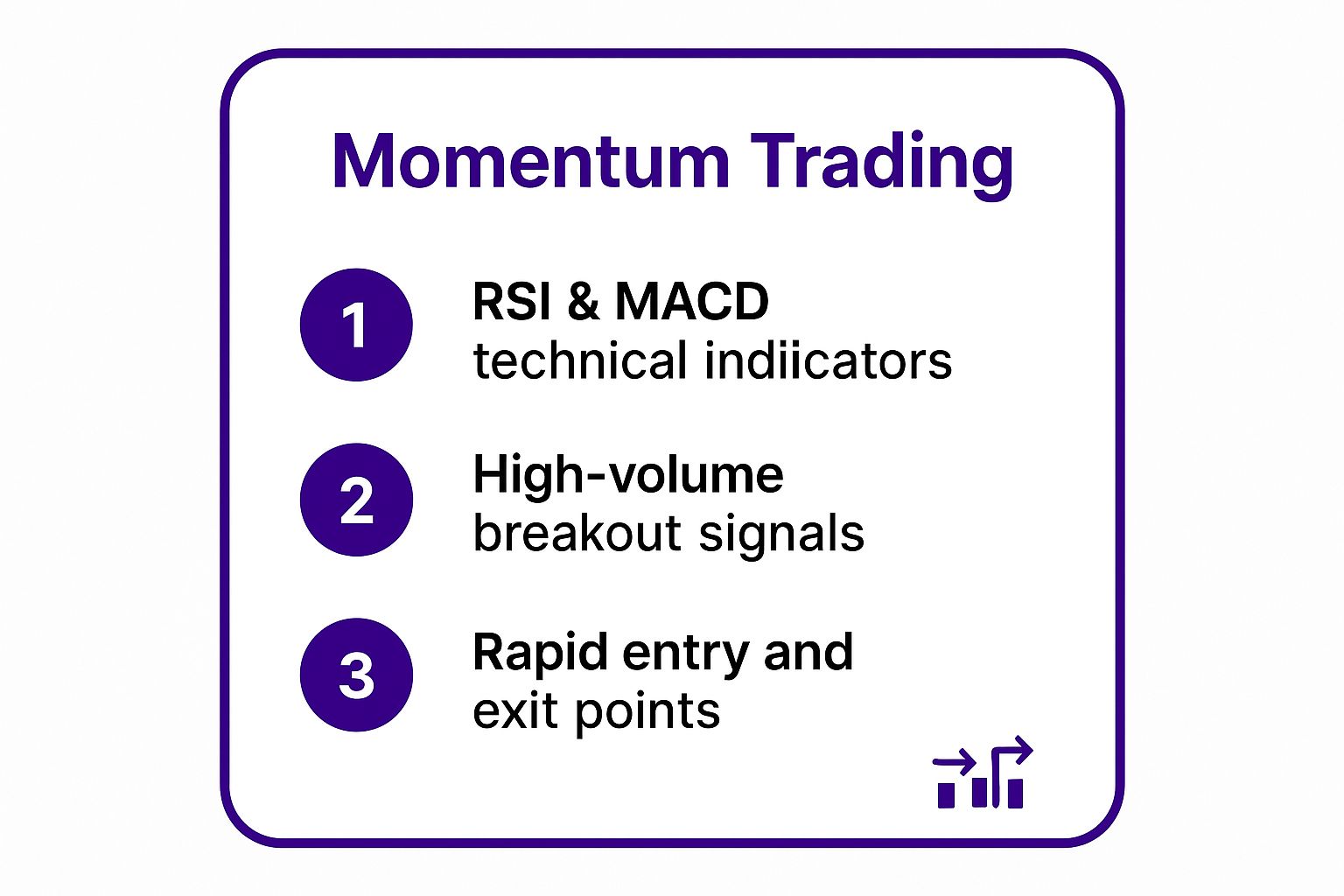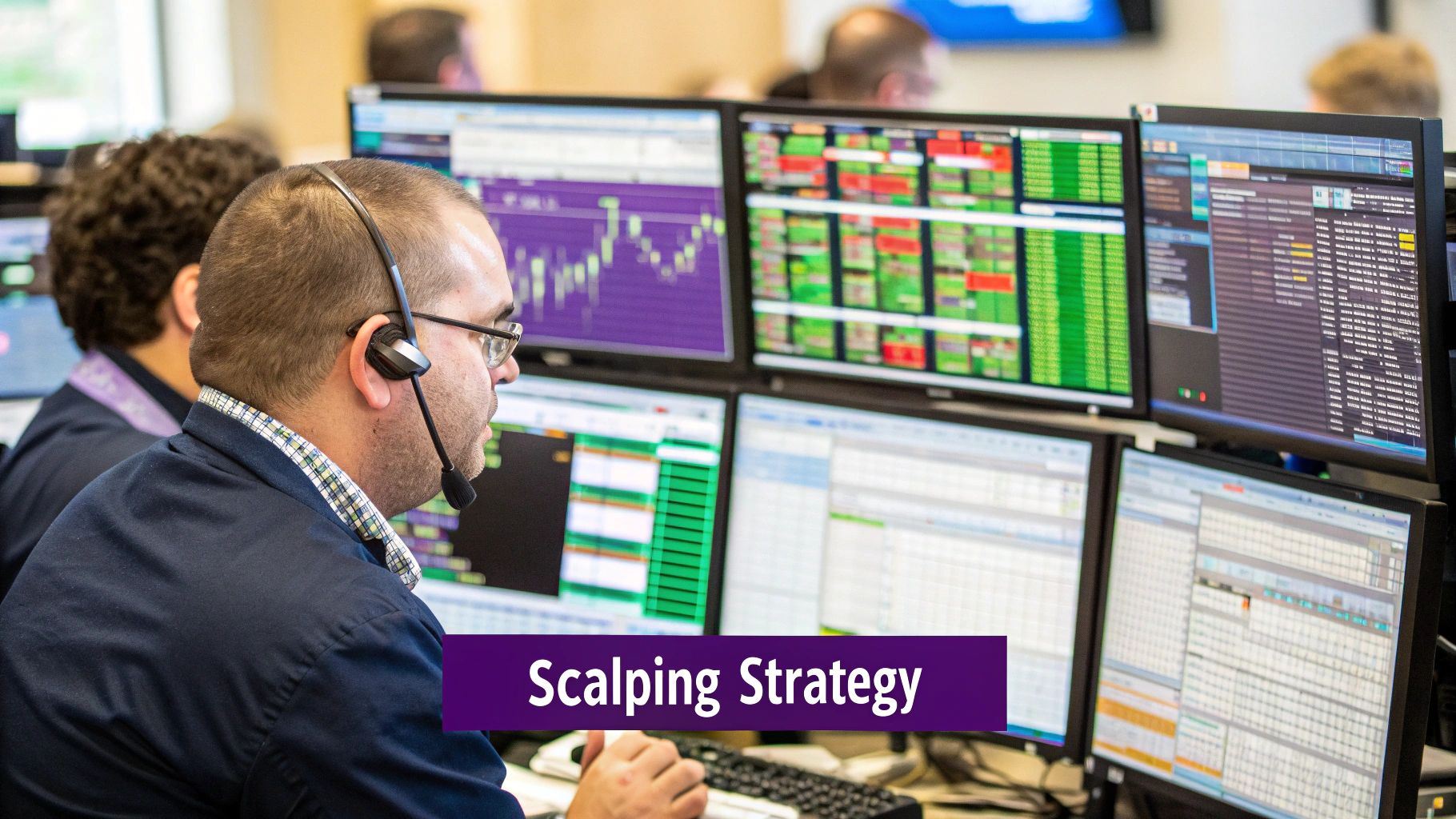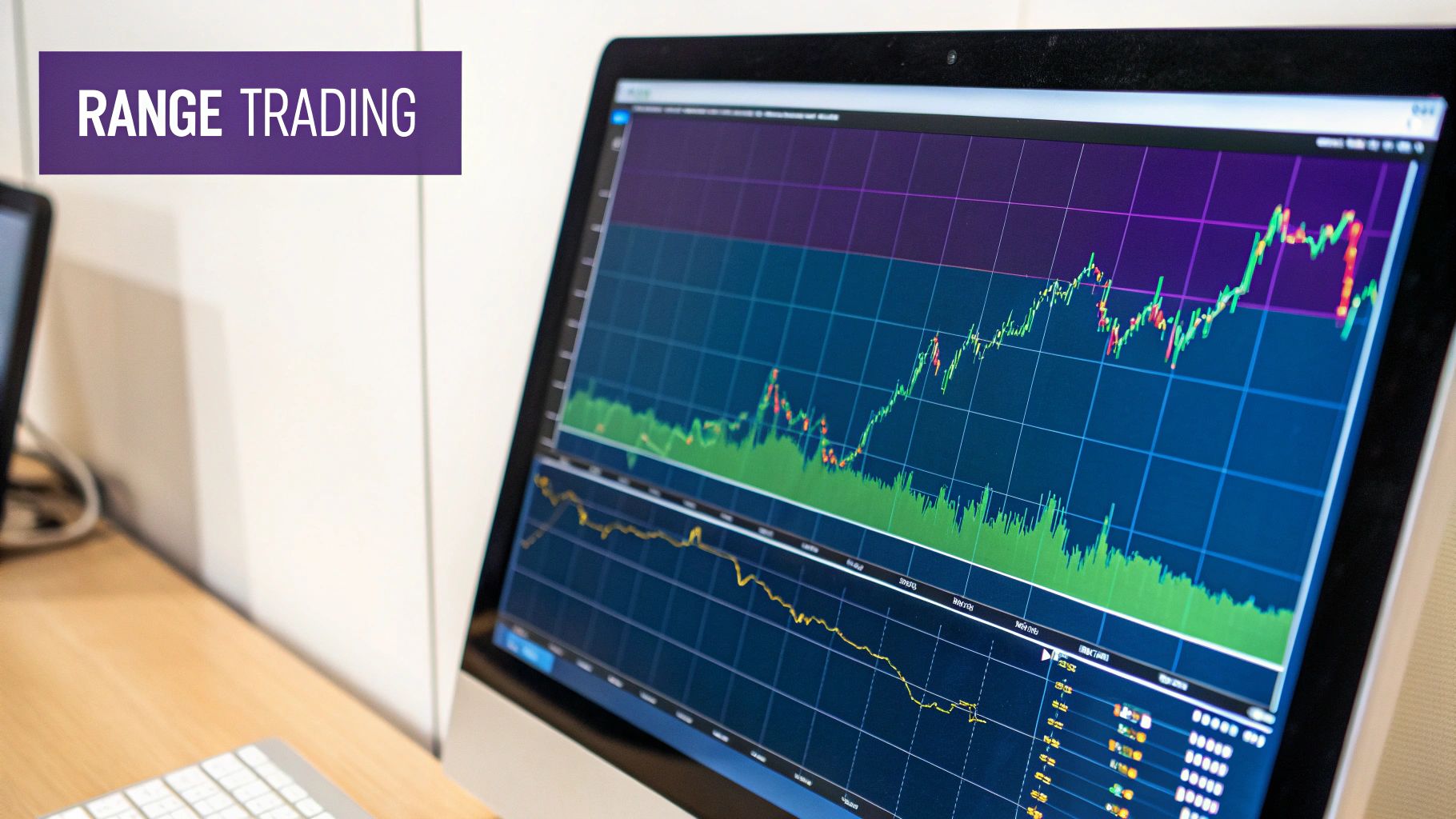Navigating the fast-paced world of digital assets requires more than just luck; it demands a structured approach. Welcome to your definitive guide on the most effective crypto day trading strategies, designed to equip you with the knowledge needed to capitalize on short-term market movements. The cryptocurrency market is known for its volatility, which, while risky, also presents numerous opportunities for disciplined traders to generate daily profits. Success in this environment hinges on understanding specific methodologies for entering and exiting trades within a single day.
This article moves beyond generic advice to provide a comprehensive breakdown of actionable strategies. We will dissect seven distinct approaches, from high-frequency scalping to capitalizing on major news events. Before diving deep into these specific day trading strategies, it's beneficial to establish a strong foundation by exploring how to Kryptowährung handeln lernen. Mastering the fundamentals of trading is a crucial first step for any aspiring trader.
Each section that follows is meticulously structured to give you a clear and practical blueprint. You will learn the core principles, ideal market conditions, and essential risk management techniques for every strategy, including:
- Momentum and Scalping: Capturing small, frequent gains.
- Range and Breakout Trading: Identifying and acting on established price channels.
- News-Based and Arbitrage Trading: Leveraging external information and market inefficiencies.
- Technical Analysis Patterns: Using chart indicators to predict price action.
By the end of this guide, you'll have a robust toolkit of crypto day trading strategies to test, refine, and integrate into your own trading system, helping you make more informed and strategic decisions.
1. Momentum Trading
Momentum trading is one of the most popular and straightforward crypto day trading strategies, built on the principle that an object in motion stays in motion. This strategy involves identifying a cryptocurrency that is making a significant price move in one direction on high volume and jumping on board to ride the trend. The goal is to capture profits from the main thrust of the price movement, not to predict tops or bottoms.
Traders aren't concerned with an asset's fundamental value; they are only focused on price action and market sentiment. When a wave of positive news or hype propels a coin upwards, momentum traders enter long positions. Conversely, when negative sentiment triggers a sell-off, they may enter short positions to profit from the downward slide. This approach thrives in the crypto market's characteristic high-volatility environment.
How Momentum Trading Works
The core of this strategy is identifying a strong trend and confirming its strength. Traders typically use technical indicators to pinpoint entry and exit signals.
A classic setup involves looking for a breakout, where a cryptocurrency’s price moves above a key resistance level or below a support level. This breakout must be accompanied by a significant spike in trading volume, which confirms that there is strong conviction behind the move. Without this volume confirmation, the breakout could be a "fakeout," a trap that quickly reverses.
For example, during the DeFi summer of 2020, many tokens like AAVE and UNI experienced parabolic rallies. A momentum trader would have identified the initial strong upward moves on their charts, confirmed the surge with high volume, and entered a trade. They would then hold the position as long as the upward momentum continued, using trailing stop-losses to protect profits before exiting as the momentum showed signs of fading.
Key Indicators and Execution
To effectively execute momentum trades, traders rely on specific technical indicators to gauge the strength and duration of a trend. The Relative Strength Index (RSI) helps identify overbought or oversold conditions, while the Moving Average Convergence Divergence (MACD) highlights changes in momentum.
The following infographic summarizes the core components of a successful momentum trading setup.

As the visualization shows, combining technical indicators like RSI and MACD with volume analysis is crucial for confirming a breakout and executing rapid, well-timed trades.
Pro Tip: Set multiple take-profit targets. For instance, you might sell 30% of your position after a 5% gain, another 30% at a 10% gain, and let the rest ride with a tight trailing stop-loss. This approach, a cornerstone of many crypto day trading strategies, helps you lock in gains while still capturing potential further upside.
2. Scalping
Scalping is a high-frequency trading strategy where traders aim to profit from small price changes, making dozens or even hundreds of trades in a single day. This approach is built on the idea that small, consistent gains can accumulate into significant profits over time. Unlike other crypto day trading strategies that hold positions for hours, scalpers typically hold trades for just seconds to minutes, capitalizing on the market's inherent volatility.

The core principle is to exploit minor fluctuations in an asset's price. Traders who use this strategy aren't looking for major trend reversals or breakouts; they are focused on capturing the small bid-ask spread or minor price movements within a tight trading range. Success requires intense focus, quick decision-making, and a deep understanding of market liquidity and order flow.
How Scalping Works
Scalping demands a systematic approach to identifying and executing trades with precision and speed. Traders often use lower timeframes, such as the 1-minute or 5-minute charts, to spot fleeting opportunities. The goal is to enter and exit a position before the market has a chance to move significantly against them.
A common setup involves identifying a highly liquid cryptocurrency, like Bitcoin (BTC) or Ethereum (ETH), and monitoring its order book closely. A scalper might place a buy order just above a large cluster of buy orders (a support level) and simultaneously set a take-profit order just a few price ticks higher. The entire trade might last less than a minute, capturing a profit of 0.1% to 0.5%. When these small gains are repeated throughout the day, they can add up.
For instance, during periods of high volatility, such as a major news announcement or an exchange listing for a new altcoin, the bid-ask spread can widen, creating numerous scalping opportunities. A trader might exploit these temporary inefficiencies by rapidly buying at the bid price and selling at the ask price.
Key Indicators and Execution
Effective scalping relies less on complex indicators and more on speed, liquidity, and cost management. While indicators like Bollinger Bands and Moving Averages can help identify a trading range, the real keys are low transaction fees and fast execution speeds. High fees can quickly erase the small profits generated from each trade.
Because scalping can be particularly sensitive to network congestion on chains like Ethereum, using tools to monitor network fees is crucial. A high gas fee can make a small trade unprofitable. You can monitor these costs in real time to better time your trades; learn more about the Ethereum gas tracker and how it impacts trading costs.
Pro Tip: Focus on one or two highly liquid trading pairs. Trying to scalp multiple assets at once can lead to missed opportunities and costly mistakes. Master the price action and order book dynamics of a single pair, like BTC/USDT, before expanding. This disciplined focus is essential for the high-speed nature of scalping.
3. Range Trading
Range trading is a disciplined crypto day trading strategy that focuses on markets moving sideways rather than trending up or down. This approach identifies a cryptocurrency whose price is oscillating between two consistent levels: a lower boundary known as support and an upper boundary called resistance. The core idea is to buy the asset near the support level and sell it near the resistance level, capturing profits within this predictable "range."
This strategy is particularly effective when markets are in a state of consolidation, often occurring after a major price move or before a significant news event. Unlike momentum traders who chase breakouts, range traders thrive on the lack of a clear directional trend. They capitalize on the market's indecision by treating support and resistance as reliable, albeit temporary, price barriers.

How Range Trading Works
The foundation of range trading is accurately identifying the upper and lower boundaries of the trading channel. A trader first analyzes a price chart to find at least two or three distinct highs (resistance) and two or three lows (support) at similar price levels. These points are then connected with horizontal lines to form the trading range.
Once the range is established, the execution plan is straightforward: place buy orders near the support line and sell orders near the resistance line. The key is patience and discipline, as traders must wait for the price to approach these predetermined levels before acting. Volume analysis is also crucial; typically, volume decreases as an asset trades within a range, confirming the lack of strong directional pressure.
For instance, throughout the summer of 2021, Bitcoin frequently traded in a well-defined range between approximately $30,000 and $40,000. A range trader would have bought near the $30,000 support level and sold as the price approached the $40,000 resistance, repeating this process multiple times to generate consistent profits during the consolidation period.
Key Indicators and Execution
While range trading seems simple, successful execution requires careful use of indicators to confirm entry and exit points and to manage risk. Oscillators like the Relative Strength Index (RSI) and the Stochastic Oscillator are extremely valuable tools for this strategy.
These indicators help gauge whether an asset is "overbought" (near resistance) or "oversold" (near support) within the context of its range. A trader might wait for the price to touch the support line and for the RSI to dip below 30 (indicating oversold conditions) before entering a long position. Conversely, they would look to sell when the price nears resistance and the RSI climbs above 70 (overbought).
Pro Tip: Always place your stop-loss orders just outside the established range. For a long position entered near support, set a stop-loss slightly below the support line. For a short position at resistance, place it just above the resistance line. This protects you from a breakout, where the price decisively breaks through the range, invalidating the strategy.
4. Breakout Trading
Breakout trading is a fundamental crypto day trading strategy that involves capitalizing on price movements after an asset breaks through a key level of support or resistance. The core premise is that once a price pierces a well-established barrier, it will gain momentum and continue moving in that direction. Traders aim to enter the trade just as the breakout occurs to ride the subsequent price wave.
This strategy is highly popular in the crypto market because digital assets often consolidate within specific price ranges for extended periods before making a powerful, decisive move. A breakout signifies a shift in market sentiment and the resolution of a battle between buyers and sellers. By identifying these critical inflection points, traders can enter positions with a clear directional bias and well-defined risk parameters.
How Breakout Trading Works
The essence of breakout trading is identifying a consolidation pattern, such as a range, triangle, or channel, and then waiting for the price to move decisively outside of it. A critical component for a valid breakout is a significant increase in trading volume. This surge in volume confirms that there is strong conviction behind the move and reduces the likelihood of a "fakeout," where the price briefly moves past a level only to reverse.
For example, Bitcoin spent several weeks consolidating below the $20,000 resistance level in late 2020. When it finally broke above this psychological barrier, it did so with immense volume, triggering a massive bull run. A breakout trader would have placed an entry order just above $20,000, anticipating this powerful continuation. Their goal is not to predict the breakout but to react to it swiftly once it is confirmed.
Key Indicators and Execution
To execute breakout trades effectively, traders must accurately draw support and resistance levels on their charts. Using multiple timeframe analysis helps confirm the significance of these levels. For instance, a resistance level that is visible on both the 4-hour and daily charts is much more significant than one that only appears on a 5-minute chart.
Indicators like the Bollinger Bands can help identify periods of low volatility (a "squeeze"), which often precede a powerful breakout. When the bands tighten, it signals consolidation, and a price move outside the bands can signal the start of a new trend. Traders also set predetermined profit targets, often by measuring the height of the previous consolidation range and projecting it from the breakout point. To learn more about the tools and platforms that facilitate these advanced analytical strategies, you can explore the features offered by platforms like V-Trader.
Pro Tip: Don't chase a breakout that has already moved significantly. Instead, be patient and wait for a retest of the broken level. Often, the price will return to test the old resistance as new support (or old support as new resistance) before continuing its trend. Entering on this retest can offer a more favorable risk-to-reward ratio.
5. News-Based Trading
News-based trading is a strategy that focuses on capitalizing on price volatility triggered by significant news events, announcements, and market developments. Unlike strategies that rely purely on technical charts, this approach requires traders to be attuned to the real-world catalysts that can dramatically impact cryptocurrency prices in a short period. The core principle is simple: positive news drives prices up, while negative news pushes them down.
This strategy is particularly effective in the crypto market, where sentiment and hype play an outsized role. A single tweet, a partnership announcement, or a regulatory update can cause immediate and substantial price movements. Traders aim to anticipate or react quickly to these events, opening positions to profit from the ensuing volatility. This makes it one of the more event-driven crypto day trading strategies.
How News-Based Trading Works
The essence of this strategy is to identify a potential market-moving event and position yourself accordingly. Traders constantly monitor a wide array of sources, including crypto news outlets, social media platforms like X (formerly Twitter), official project blogs, and government press releases. The goal is to be among the first to act on the information before it becomes widely priced into the market.
A classic example is a major exchange listing announcement. When a prominent exchange like Coinbase or Binance announces it will list a smaller altcoin, that coin's price often skyrockets due to the sudden increase in accessibility, liquidity, and perceived legitimacy. A news-based trader would aim to buy the asset moments after the announcement, riding the initial wave of buying pressure.
For instance, the announcement of Tesla's $1.5 billion Bitcoin purchase in February 2021 sent BTC's price soaring. Traders who were monitoring SEC filings or major news alerts and acted quickly could have captured significant gains. Similarly, news of China's crackdown on crypto mining created intense selling pressure, offering profitable shorting opportunities.
Key Indicators and Execution
Effective news-based trading is less about technical indicators and more about information speed and verification. Success hinges on your ability to quickly filter credible news from noise and act decisively. While you still need charts to identify entry and exit points, the catalyst for the trade is external information.
Traders often use news aggregators, set up alerts for specific keywords, and follow key influencers and project leaders on social media. It is crucial to have positions ready or a plan in place before scheduled events, such as a major network upgrade or a central bank policy announcement. Due to the extreme volatility that often follows major news, using tight stop-losses is non-negotiable to manage risk. For more details on managing positions in a volatile environment, you can check out platforms like V-Trader, which provide comprehensive resources and FAQs. You can learn more about managing crypto trading risks on vtrader.io.
Pro Tip: Don't just trade the news; trade the reaction. Sometimes the market's reaction is counterintuitive (a "buy the rumor, sell the news" event). Wait for the initial price action to confirm the market's interpretation of the news before entering a trade. This helps avoid whipsaws and false moves.
6. Arbitrage Trading
Arbitrage trading is a quantitative crypto day trading strategy that leverages price inefficiencies across different markets. It involves simultaneously buying and selling the same cryptocurrency on different exchanges or in different trading pairs to lock in a profit from the price discrepancy. Unlike strategies that rely on predicting market direction, arbitrage is market-neutral and aims for smaller, lower-risk gains by exploiting temporary pricing gaps.
This strategy's appeal lies in its mathematical foundation. The profit is the difference between the prices minus any associated fees. In the highly fragmented and 24/7 crypto market, where hundreds of exchanges operate independently, these price discrepancies appear frequently, although they are often short-lived. This makes speed and automation critical components for success.
How Arbitrage Trading Works
The core principle of arbitrage is buying low on one exchange and selling high on another, all at the same moment. For this to work, a trader needs to have accounts funded with both fiat (like USD) and the specific crypto on at least two different exchanges. When a price difference is detected, the trader executes the buy and sell orders instantly.
For example, a trader might notice that Bitcoin (BTC) is trading for $60,000 on Coinbase but $60,150 on Binance. An arbitrageur would simultaneously buy 1 BTC on Coinbase and sell 1 BTC on Binance, capturing a gross profit of $150 before fees. Another common approach is triangular arbitrage, which involves exploiting price differences between three currencies on the same exchange, such as moving from USD to BTC, then BTC to ETH, and finally ETH back to USD to end with more than the starting capital. Learning how to find arbitrage opportunities is the first and most crucial step for traders looking to master this method.
Key Indicators and Execution
Arbitrage doesn't rely on traditional technical indicators like RSI or MACD. Instead, it requires real-time price data feeds from multiple exchanges and sophisticated software or bots to execute trades instantly. The main "indicator" is the price spread itself.
Execution must be lightning-fast, as these opportunities can vanish in seconds due to other arbitrageurs. This is why most serious arbitrage is performed by automated trading bots that can monitor prices and execute orders far faster than any human. Traders must also meticulously account for all costs, including trading fees, network gas fees, and exchange withdrawal fees, as these can easily erase the slim profit margins. For those interested in automated solutions and integrated trading environments, you can learn more about staking on Vtrader.io.
Pro Tip: Before committing capital, run simulations to account for all potential fees. Trading fees are straightforward, but don't forget withdrawal fees and network transaction times. Sometimes a profitable-looking spread can become a loss once you factor in the cost and time it takes to move assets between exchanges.
7. Technical Analysis Pattern Trading
Technical Analysis (TA) Pattern Trading is a foundational strategy that involves identifying and acting on classic chart patterns. These visual formations, shaped by an asset's price movements, are believed to reflect the underlying psychology of the market and can often predict future price direction. By recognizing patterns like triangles, flags, head and shoulders, or double tops/bottoms, traders can anticipate potential breakouts or reversals.
This approach is one of the most widely used crypto day trading strategies because it provides a clear, visual framework for making decisions. Instead of relying solely on raw numbers or complex indicators, traders interpret the "story" told by the price chart itself. These recurring shapes offer clues about the ongoing battle between buyers and sellers, helping traders to time their entries and exits with greater precision.
How Technical Analysis Pattern Trading Works
The core of this strategy lies in recognizing a specific pattern as it forms on a price chart and waiting for a confirmation signal to trade it. Each pattern has its own distinct set of rules for entry, stop-loss placement, and price targets. For instance, a "head and shoulders" pattern is a classic bearish reversal signal, suggesting an uptrend is losing steam and a downtrend is likely to begin.
Traders look for a pattern completion and a breakout from a key level, such as the "neckline" in a head and shoulders formation. A crucial element is to confirm this breakout with a significant increase in trading volume. High volume indicates strong market participation and conviction, validating the pattern and reducing the risk of a "fakeout" where the price quickly reverses.
For example, many altcoins formed clear double bottom patterns during bear market capitulations. A pattern trader would identify the two distinct lows at a similar price level, wait for the price to break above the intervening peak (the resistance level), and enter a long position. The price target would typically be measured by taking the height of the pattern and adding it to the breakout point.
Key Indicators and Execution
While patterns are powerful on their own, they become more reliable when combined with other technical indicators. The Relative Strength Index (RSI) can help confirm momentum, while moving averages can highlight the prevailing trend context. Volume is arguably the most critical companion indicator for pattern trading.
Successful execution requires discipline and patience. Rather than jumping into a trade while a pattern is still forming, experienced traders wait for the confirmation of a breakout. For more information, you can find a wealth of educational materials to help you master these techniques; for instance, you can learn more about technical analysis patterns and their applications to build a solid foundation.
Pro Tip: Never trade a pattern in isolation. Always consider the broader market trend. A bullish continuation pattern like a bull flag is far more likely to succeed in an overall uptrend, while a bearish reversal pattern like a double top carries more weight in a downtrending market. Context is key to improving your success rate with this strategy.
Top 7 Crypto Day Trading Strategies Comparison
| Strategy | Implementation Complexity 🔄 | Resource Requirements ⚡ | Expected Outcomes 📊 | Ideal Use Cases 💡 | Key Advantages ⭐ |
|---|---|---|---|---|---|
| Momentum Trading | Moderate to High – requires technical indicators and quick decisions | Moderate – needs real-time data and monitoring | High profits in trending markets | Trending markets with strong directional moves | Capitalizes on strong trends; automatable |
| Scalping | High – very fast execution and constant focus | High – advanced tools, low latency execution | Small consistent profits multiple times daily | Highly volatile intraday markets | Limited overnight risk; exploits small price moves |
| Range Trading | Moderate – identifying support/resistance | Low to Moderate – chart analysis and patience | Stable profits during sideways markets | Consolidating or sideways trending markets | Clear entry/exit points; lower risk than trend trading |
| Breakout Trading | Moderate to High – needs volume confirmation and quick execution | Moderate – relies on volume and multi-timeframe analysis | Captures large moves early in trends | Markets poised for strong directional breakouts | Objective entry signals; aligns with explosive moves |
| News-Based Trading | High – constant news monitoring and analysis | High – research, multiple sources, fast reaction | Profits from major news events | News-driven, volatile markets | Can anticipate moves before technical signals |
| Arbitrage Trading | High – requires automation and multi-exchange access | High – substantial capital, multiple exchange accounts | Low risk, steady returns from price discrepancies | Exploiting price differences across exchanges | Theoretically risk-free; market neutral |
| Technical Analysis Pattern Trading | Moderate – requires pattern recognition skill | Moderate – charting tools, multi-timeframe analysis | Consistent with risk management | Any market with repeating price patterns | Structured approach; clear risk controls |
Choosing Your Strategy and Mastering Execution
Navigating the volatile landscape of the cryptocurrency market requires more than just luck; it demands a well-defined plan. Throughout this guide, we've dissected seven distinct and powerful crypto day trading strategies, from the rapid-fire precision of Scalping to the calculated patience of Range Trading and the event-driven tactics of News-Based Trading. Each approach offers a unique lens through which to view market dynamics and a specific toolkit for capitalizing on short-term price movements.
We explored how Momentum traders ride the waves of market sentiment, how Breakout traders position themselves for explosive moves, and how Arbitrageurs exploit minute price discrepancies across different exchanges for low-risk profits. We also delved into the art of Technical Analysis Pattern Trading, demonstrating how classic chart formations can signal predictable market behavior. The common thread weaving through all these methods is the non-negotiable need for discipline, rigorous risk management, and a commitment to continuous learning.
Synthesizing Strategy with Personal Style
The most critical takeaway is that there is no single "best" crypto day trading strategy. The ideal approach for you is one that aligns seamlessly with your personality, risk tolerance, and lifestyle.
- For the Adrenaline Seeker: If you thrive on high-frequency action and can make split-second decisions under pressure, Scalping or high-velocity Momentum Trading might be your arena. These demand constant attention and an intuitive feel for market flow.
- For the Patient Analyst: If you prefer a more methodical, less frantic pace, Range Trading or Technical Analysis Pattern Trading could be a better fit. These strategies rely on identifying established patterns and patiently waiting for the optimal entry and exit points.
- For the Strategic Opportunist: If you excel at connecting broader events to market impact, News-Based Trading allows you to leverage your analytical skills. Similarly, if you have a knack for identifying inefficiencies, Arbitrage Trading offers a more systematic, data-driven path.
Key Insight: Your trading strategy should feel like a natural extension of your analytical strengths. Forcing yourself into a style that clashes with your personality is a direct path to emotional decision-making and costly errors. The goal is to find a methodology that reduces stress, not one that amplifies it.
From Theory to Profitable Execution
Understanding these strategies is only the first step. True mastery comes from consistent application, refinement, and an unwavering commitment to your trading plan. Before you risk significant capital, your focus should be on building a robust execution framework.
This involves several actionable steps:
- Backtesting Your Chosen Strategy: Use historical chart data to manually or automatically test how your chosen strategy would have performed in past market conditions. This process builds confidence and helps you refine your entry, exit, and stop-loss criteria.
- Paper Trading in a Live Environment: Transition from historical data to a live market simulation. This is where you practice executing trades in real-time without financial risk. It's an invaluable opportunity to hone your reaction speed, manage your emotions, and validate your strategy's effectiveness against current market volatility.
- Developing an Ironclad Risk Management Protocol: Define exactly how much capital you will risk per trade (e.g., 1-2% of your total trading account). Determine your stop-loss placement rules before entering any position and stick to them without exception. This single habit is what separates sustainable traders from those who burn out.
- Creating a Detailed Trading Journal: Document every single trade. Note the strategy used, the reason for entry, the profit target, the stop-loss level, and the eventual outcome. Regularly review your journal to identify recurring mistakes, successful patterns, and areas for improvement.
Mastering these crypto day trading strategies is not about finding a secret formula for guaranteed wins. It's about developing a professional process that gives you a statistical edge over the long run. It’s about transforming yourself from a gambler reacting to market noise into a strategist executing a well-rehearsed plan. The journey is challenging, but the potential rewards, both in financial growth and personal discipline, are immense.
Ready to put these strategies into practice with a platform built for performance? vTrader offers the advanced charting tools, real-time data, and ultra-low latency execution you need to master the art of crypto day trading. Explore our suite of analytical features and start your journey on a platform designed for serious traders. vTrader

Steve Gregory is a lawyer in the United States who specializes in licensing for cryptocurrency companies and products. Steve began his career as an attorney in 2015 but made the switch to working in cryptocurrency full time shortly after joining the original team at Gemini Trust Company, an early cryptocurrency exchange based in New York City. Steve then joined CEX.io and was able to launch their regulated US-based cryptocurrency. Steve then went on to become the CEO at currency.com when he ran for four years and was able to lead currency.com to being fully acquired in 2025.


